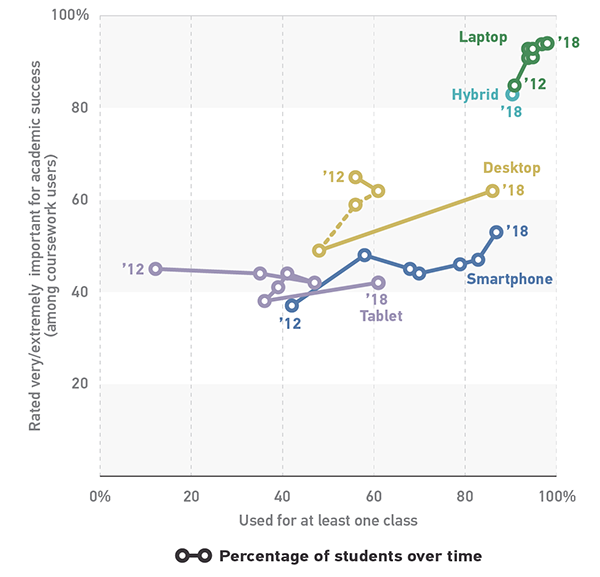Device Use and Importance
Since 2012, we have tracked the frequency with which students use various technologies for their coursework and the levels of importance students attribute to these technologies for their academic success. We should not be surprised that student use of and the importance placed on those technologies for students' success are significantly and positively correlated: The more courses in which students use the various devices, the more important they consider those devices to be in accomplishing academic tasks successfully (see figure 2). Laptops continue to reign supreme, with 98% of students reporting using them in at least one course last year and 94% rating them very or extremely important.1 Similarly, smartphone usage and importance both increased modestly since 2017, continuing an upward trend for the third year in a row. More surprising is the reversal of fortunes for desktops and tablets. After two consecutive years of decline in importance and use, these devices have experienced a substantial rebound, especially in terms of the percentage of students who have used them for at least one course.2 Comparatively fewer students reported high levels of use or importance with many of the newer and/or narrower technologies such as AR and VR headsets, smartwatches, gaming devices, streaming media devices, and voice-controlled speakers/assistants.

Students' assessment of the importance of different devices varies considerably. And the importance of these devices also varies for some important demographic groups. For example, students who come from lower-income families,3 are non-white, and cannot be claimed by their parents as dependents are significantly more likely to see desktops as important to their academic success than wealthier, white, and dependent students. Additionally, women are significantly less likely than men to see desktops as important. Holding all other factors constant, women are significantly more likely than men to view laptops as important. Smartphones are significantly more important to non-white, first-generation college students, students whose families have lower incomes, and those with disabilities. Although white students are significantly less likely to think of tablets as important, independent, first-generation, non-white, and disabled students attribute significantly greater levels of importance of tablets to their academic work.4
In 2017 we reported that an increased number of students said their instructors were banning or discouraging the use of tablets (40%) and smartphones (70%) in class. Only 19% of students reported their instructors banned or discouraged the use of laptops in class last year.5 Faculty reported a similar pattern of banning and discouraging student use of laptops (20%), tablets (24%), and smartphones (52%) in their classrooms.6 In some cases, faculty ban or discourage devices in classrooms on the basis of research that simply confirms their biases against those digital devices—that they are distracting, that student device usage implies disrespect or a lack of attention, or that students are not taking good notes. This approach can do real, if unintended, harm.
Instructor policies that ban or discourage mobile device use in the classroom may disproportionately affect students of color, students with disabilities, first-generation students, students who are independent (with or without dependents of their own), and students who come from disadvantaged socioeconomic backgrounds. Given that these groups of students attach high levels of importance to these devices for their academic success, instructors should set aside their concerns about the use of such devices in class. The collective impact of our findings suggests that policies that ban and discourage student device use in the classroom may very well undermine the efforts of women, students of color, lower-income students, and students with disabilities to leverage their devices in ways that help them succeed in college.
Notes
-
Hybrid or 2-in-1 devices (e.g., Lenovo Yoga, Microsoft Surface) are the technologies that are closest to laptops in terms of students using them for at least one course (90%) and rating them as very to extremely important to their academic success (83%). Their relative usage and importance may be a product of the similar power and versatility of such devices to laptops. However, the relative position of hybrids to laptops is inflated given that only 11% of students reported having access to hybrid devices compared to 91% of students who have access to laptops.
↩︎ -
Note that student use of desktops for coursework is significantly related to major. Majors for a majority of students who report using desktops in most to all of their courses include computer and information sciences (59%), engineering and architecture (56%), public administration, legal, social, and protective services (54%), and humanities (51%).
↩︎ -
Here we use students' self-reported Pell Grant eligibility as a proxy for lower income levels among students.
↩︎ -
Reported results are derived from multivariable ordered logistic regression models controlling for demographic predictors of device importance levels. All reported results are statistically significant at the p < .001 level.
↩︎ -
D. Christopher Brooks and Jeffrey Pomerantz, ECAR Study of Undergraduate Students and Information Technology, 2017, research report (Louisville, CO: ECAR, October 2017).
↩︎ -
Jeffrey Pomerantz and D. Christopher Brooks, ECAR Study of Faculty and Information Technology, 2017, research report (Louisville, CO: ECAR, October 2017).
↩︎